GAO Highlights Challenges Facing Tribal Energy Development and Permitting Processes
September 10, 2025 | Indian Affairs: Senate Committee, Standing Committees - House & Senate, Congressional Hearings Compilation
This article was created by AI summarizing key points discussed. AI makes mistakes, so for full details and context, please refer to the video of the full meeting. Please report any errors so we can fix them. Report an error »

In a recent government meeting, discussions centered around the nomination of William Kirkland for the position of Assistant Secretary for Indian Affairs and the challenges faced by tribal energy development. The meeting highlighted significant barriers that Native American tribes encounter when trying to harness energy resources on their lands.
One of the key issues raised was the lengthy permitting process that tribes must navigate, particularly when dealing with trust lands and complex ownership structures. These challenges often lead to delays in project development, which can hinder economic growth and energy independence for tribal communities. The Government Accountability Office (GAO) has documented these issues over the years, emphasizing the need for a clearer understanding of revenue models and administrative capacities within tribal governments.
Tribes frequently face additional hurdles, such as extensive environmental reviews that can prolong project timelines. These reviews are sometimes necessary due to the presence of cultural resources on tribal lands, which must be carefully considered. While these processes are important for protecting cultural heritage, they can also complicate and delay energy projects.
Moreover, many tribes lack the administrative capacity to effectively access federal funds, which further exacerbates the challenges they face in energy development. The meeting underscored the need for a more supportive framework that recognizes the unique structures and revenue models of tribal governments.
As the Senate Committee on Indian Affairs continues to explore these issues, the outcomes of this meeting could have lasting implications for tribal energy initiatives and the economic well-being of Native American communities. Addressing these barriers is crucial for empowering tribes to fully participate in energy development and achieve greater self-sufficiency.
One of the key issues raised was the lengthy permitting process that tribes must navigate, particularly when dealing with trust lands and complex ownership structures. These challenges often lead to delays in project development, which can hinder economic growth and energy independence for tribal communities. The Government Accountability Office (GAO) has documented these issues over the years, emphasizing the need for a clearer understanding of revenue models and administrative capacities within tribal governments.
Tribes frequently face additional hurdles, such as extensive environmental reviews that can prolong project timelines. These reviews are sometimes necessary due to the presence of cultural resources on tribal lands, which must be carefully considered. While these processes are important for protecting cultural heritage, they can also complicate and delay energy projects.
Moreover, many tribes lack the administrative capacity to effectively access federal funds, which further exacerbates the challenges they face in energy development. The meeting underscored the need for a more supportive framework that recognizes the unique structures and revenue models of tribal governments.
As the Senate Committee on Indian Affairs continues to explore these issues, the outcomes of this meeting could have lasting implications for tribal energy initiatives and the economic well-being of Native American communities. Addressing these barriers is crucial for empowering tribes to fully participate in energy development and achieve greater self-sufficiency.
View full meeting
This article is based on a recent meeting—watch the full video and explore the complete transcript for deeper insights into the discussion.
View full meeting